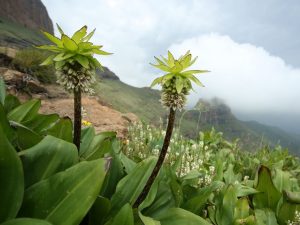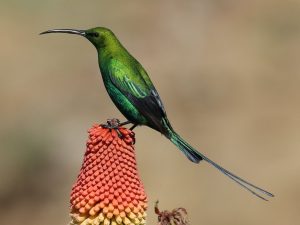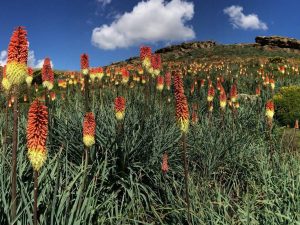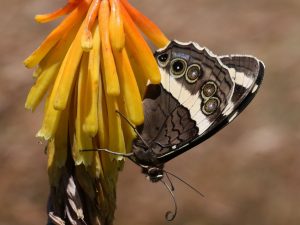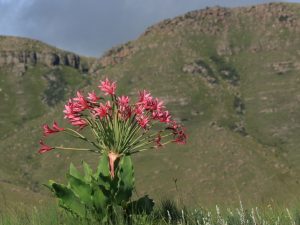
mountain flowers on the roof of South Africa
Spectacular wild flowers, big game, mountain birds and rich history on the ‘Roof of Africa’.
Download leaflet
Wildlife Travel leaflet Drakensberg 2026
Dates
16th – 29th January 2026
new holiday
fully booked
Leader
Price
£5,750
Single Room Supplement – £420
Included
Return flight London Heathrow to Johannesburg. Local transport as specified in itinerary. Eleven nights accommodation, full board.
Not included
Refreshments. Gratuities. Travel insurance. Visa costs. Covid tests and associated costs.
Group size
Minimum 5, maximum 10.
The Drakensberg escarpment – “the mountains of the dragon” – is the highest mountain region in southern Africa, reaching heights of over 3000 metres and curving up from the Eastern Cape around Lesotho and towards KwazuluNatal. More than 2000 species of plants are found here, of which almost one fifth are endemic, found nowhere else.
These awe-inspiring mountains have been designated as a World Heritage Site both for its scenic and natural diversity and for the area’s cultural significance. The caves and cliffs of these mountains hide one of the greatest concentrations of rock art in the world, with more than 40,000 pictures at over 600 sites, at least one of which we will visit during our tour.
January is the start of the South African summer and our visit is timed to coincide with the peak flowering season in the mountains. Among the many highlights of the trip we can hope to see fields of Kniphofia red hot pokers, delicate orchids and wonderful proteas in full bloom.
For those who can drag their attention away from the amazing flowers of the mountains, the Drakensberg offers much else of interest. There is a rich natural history which should appeal to all. Wild game we may encounter includes Blesbok, Black Wildebeest and the stately Eland. The area has a rich bird diversity, including local specialities such as Drakensberg Rock-Jumper, Gurney’s Sugarbird and the elegant Malachite Sunbird, which visit the flowering proteas to feed on nectar, while overhead we may catch sight of a majestic Bearded Vulture.
Please note that holidays change, although sometimes only slightly, from year to year and previous trip reports may not reflect the planned itinerary, or other holiday details, for the current trip. Please ask us if you would like to know of any significant differences.
Day 1 Our evening flight takes us from London, arriving in Johannesburg early on Day 2, where we connect to a short flight to Durban, and then drive to the base of the Drakensberg mountains.
Day 3 Today we slowly ascend the Sani Pass by four-wheel-drive, stopping along the way to look for the special flora. Sani Pass is world famous for its flora and the ascent gives us a chance to appreciate how the species change with altitude. The list of special plants we might see today is very long, including Sandersonia aurantica along streams at the bottom of the pass, Dierama dracomontana on grassy hillslopes, Protea dracomontana and the dramatic Gladiolus flanaganii growing out of sheer basalt cliffs near the top of the pass. Drakensberg Rock-jumpers and Drakensberg Siskins are bird specials of the upper reaches. Tonight we spend in a lodge perched on the lip of the escarpment with sweeping views across the Drakensberg.
Day 4 For our second day around the Sani Pass, we will explore the harsh alpine plateau inland into Lesotho, enjoying and Rhodohypoxis baurii on the rocks, alpine Helichrysum species, Sloggett’s Ice Rat and Malachite Sunbird. Finally, we’ll head slowly down the pass, spending more time searching for species that we might have missed on the way up, before ending up back in Underberg for the night.
Day 5 A day targetting mid-altitude species. We hope to access a marshy area where the pink orchid Satyrium hallacki grows in profusion alongside the large Disa cooperi. Grey-crowned Crane is a special bird of the area, where large stands of Crocosmia paniculata are found along the roadsides.
Day 6 We head north, a scenic drive to Giant’s Castle in the central Drakensberg, stopping along the way to admire Hesperantha coccinea along the streamsides, the candelabras of Brunsvigia undulata and many more. night Giant’s Castle
Day 7 The focus of the morning will be a walk to the famous Bushman paintings cave, birding and botanising along the way. The open grasslands can be full of flowers, including Moraea brevistyla. The forest near the mouth of the cave has Crocosmia aurea along the edges and Streptocarpus gardenii on the giant moss-covered boulders. Silver Protea roupelliae line the paths in places, often with Gurney’s Sugarbirds and Malachite Sunbirds, and this is a good place to see Eland, the largest antelope in the world and the equally spectacular Bush Beauty butterfly.
Day 8 Today we’ll walk the riverside trail, looking for specials such as Gomphostigma virgatum, while Jackal Buzzards and Bearded Vultures fly overhead, before heading north on the long journey to Golden Gate National Park. night Golden Gate Hotel
Day 9 We’ll explore the Golden Gate National Park, famous for its scenic sandstone buttresses and herds of plains game such as Black Wildebeest, as well as it mid-altitude flora that includes Agapanthus campanulatus.
Days 10-12 Today we head up towards the Sentinel and settle in to the upgraded Witsieshoek Mountain Lodge with sweeping views over the amphitheatre of the Drakensberg, and begin our exploration of the famous Sentinel / Witsieshoek area, spanning the upper reaches of Royal Natal Park. The area has an abundance of Moraea and Eucomis species, Kniphofia thodei and Dianthus basuticus, amongst a huge diversity of alpines and around 15 species of orchids. On one day we might do a more difficult (optional) hike towards the Chain Ladders, hoping to see some of the high altitude specials such as Nerine bowdeni which will just have started to flower. Drakensberg Rock-jumpers are found on the scree slopes, with Mountain Beauty butterflies in the lower altitude areas.
Day 13 After some last botanising, we drive northwards across the grassy highveld plateau eventually reaching Johannesburg International airport in time for our evening flight back to London, arriving Day 14.
Please note that the itinerary may be changed to suit the weather or other practicalities at the discretion of the leaders.
All of the lodges and hotels are of a good standard, some with very attractive settings. All the rooms have private bathrooms. All meals are included, with picnic lunches.
We will be travelling by minvan for this trip, transferring to four wheel drives for the Sani Pass, to reach the best of the wild flower habitats. We will do our best to ensure that our travelling is as comfortable as possible, taking plenty of stops for comfort breaks and to enjoy interesting areas.
Group flights
Group flights are with British Airways from London Heathrow to Johannesburg.
16th January depart London Heathrow 21.15, arrive Johannesburg 10.20 (17th)
17th January depart Johannesburg 12.45, arrive Durban 13.55
28th January depart Johannesburg 19.45, arrive London Heathrow 05.00 (29th)
Time zone
South Africa is two hours ahead of UK time.
Entry requirements
If you hold a British passport you can travel to South Africa for up to 90 days without a visa. Your passport must have an ‘expiry date’ at least 30 days after the date you leave South Africa, and have at least two blank pages.
It is mid-summer in the Drakensberg and a wide range of temperatures can be expected. It can be hot at lower altitudes (up to 30C), but most of our time will be at medium to high altitudes where it will be milder and often cold in the evenings. At higher altitudes, it is often warm in the direct sun but otherwise cool if there is a breeze. We can expect some rain, most of which falls in very dramatic late afternoon and night thunderstorms.
You will need to have a reasonable level of general fitness to get the most from the holiday. Although most of the walks are not long, we will sometimes be walking on uneven, rocky terrain or wet ground. Walking boots (lightweight ok) are essential for most areas. There are a few occasions when we walk uphill but this is not excessive.
We will be spending time at altitudes of c 3,250m asl. There is some risk of altitude sickness although rest and drinking plenty of water usually relieve any mild effects (headaches and tiredness). If you have suffered from altitude problems before or are suffering from any medical condition, you should take your doctor’s advice. We will be taking it easy at these higher altitudes and none of the walking will be strenuous.

